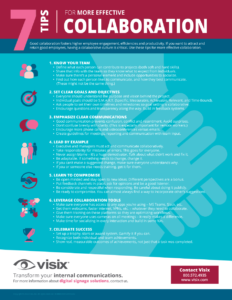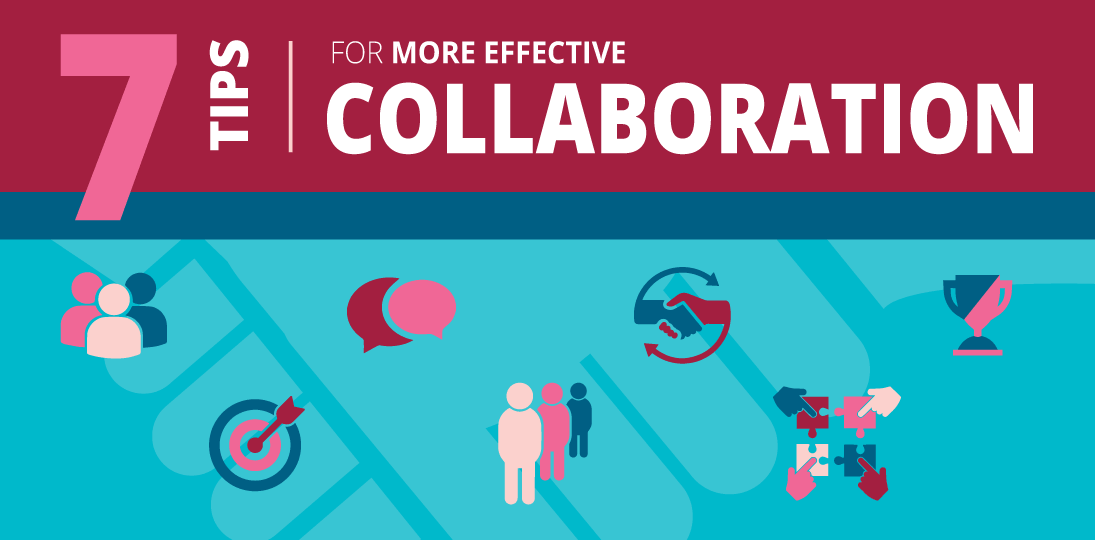Good collaboration fosters higher employee engagement, efficiencies and productivity. If you want to attract and retain good employees, having a collaborative culture is critical. Use these tips for more effective collaboration.
1. Know your team.
- When you have a new project, look at what each person can contribute in terms of both soft and hard skills when putting together a team.
- Share that information with everyone so they know what each person can contribute and what’s expected of them.
- Make sure there’s a personal element to build camaraderie. Include opportunities to socialize and have a “getting to know each other” session.
- Find out how each person likes to communicate, and how they best communicate. (These might not be the same thing.)
- If one person prefers chat to email, make that known.
- If someone has a tendency to write long emails that no one reads, ask them to hold a quick videoconference instead.
2. Set clear goals and objectives.
- Everyone should understand the purpose and vision behind the project.
- Goals should be S.M.A.R.T. (Specific, Measurable, Achievable, Relevant, and Time-Bound).
- Invite people to estimate how long their own work will take so goal setting is collaborative.
- Set milestones to measure progress against goals along the way.
- Make sure each person knows how their own contribution will be measured.
- Encourage questions and transparency along the way. Build in feedback systems.
3. Emphasize clear communications.
- Good communication prevents confusion, conflict and resentment. Someone shouldn’t be surprised by a deadline they didn’t know about or something they were supposed to do differently.
- Don’t confuse brevity with clarity. This is especially important for remote workers who can’t pop into a cubicle to ask quick questions.
- Encourage more phone calls and videoconferences versus emails. We all have too much email.
- Create some guidelines up front, with team input:
- Is there a meeting schedule? Do we need to publish agendas in advance?
- How to report progress and how often
- Which portals to use for what – email, chat, project management software, etc.
- This is great to have documented if you add new members to the team.
4. Lead by example.
- Executive and managers have to act and communicate collaboratively.
- Take responsibility for mistakes or errors. This goes for everyone.
- Never assign blame – it’s a huge demotivator. Talk about what didn’t work and fix it.
- Be adaptable. If something needs to change, change it. You can always change it again.
- Inaction can be a huge demotivator. If you can’t make a change people have discussed, make sure everyone understands why.
- If you or someone else needs training in soft skills (like collaboration) or hard skills, get it for them.
5. Learn to compromise.
- Be open minded and stay open to new ideas, even if you’re repeating a project that you’ve done before. Different perspectives are a bonus, not a challenge to your authority.
- Put feedback channels in place and be a good listener.
- Don’t just send out a survey, conduct one-on-one conversations.
- Check in periodically with everyone. Even if you tell people you’re always open to suggestions, folks won’t always come forward unless prompted.
- Always be considerate and respectful when responding. Think carefully on what should or should not be a public response.
- People have different levels of sensitivity. Some people might see even the slightest negative amplified if said in front of others.
- Peer recognition is important to people, but public shaming is horrible.
- Be ready to compromise. Even if you have a clear plan in your head, you can almost always find a way to incorporate other’s suggestions.
- If one person is running the show, that’s project management, not collaboration.
6. Leverage collaboration tools.
WebEx hybrid work research showed employees want better tech at work and at home:
- 94% of employees want tools to improve their meeting experience at home
- 96% need intelligent workplace tech to improve work environments
A Gartner Survey shows nearly 80% of workers are using collaboration tools for work in 2021
- Make sure everyone has access to any apps you’re using – MS Teams, Slack, etc.
- Get them webcams, faster internet, VPNs, etc. – whatever they need to collaborate.
- Get them training on these platforms.
In a study by Knoll, they found “employees increasingly desire social connection and engagement as part of their collaborative experience.” Collaboration apps can help.
- Make sure everyone uses cameras on all meetings – it really makes a difference.
- Make time for socializing in every interaction (can be brief).
- Build in some fun and some “getting to know you” activities .
7. Celebrate success.
- Employee recognition is a huge motivator. According to surveys:
- 44% of employees switch jobs because of not getting adequate recognition for their efforts.
- 52% of employees want more recognition from their immediate manager.
- Set up a trophy, stars or award system. Gamify it if you can.
- Recognize both individual and team achievements.
- Show real outcomes of achievements, not just that a task was completed.
- Example: Instead of “we moved 120 clients to our new support portal”, show “our customer satisfaction rating has increased by 25% since we’ve moved 120 clients to our new support portal”.

